

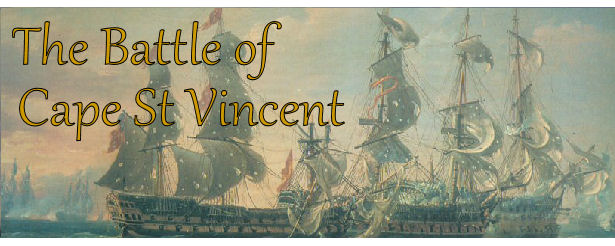
The Morning of Battle
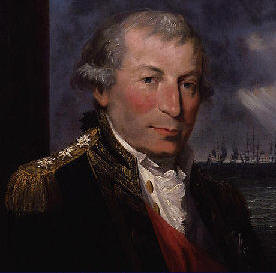 Dawn
on the 14th February 1797 was a misty one, with light breezes. Following
Admiral Sir John Jervis' orders, the British fleet had formed a close order of
sailing during the night, and had maintained it until the morning. So
when, at 8.20am as the reports of enemy sightings began to come in, Jervis
signalled the fleet to prepare for battle, they did not need to waste time
forming up. As soon as they reached the enemy, they would be ready to
swoop down upon them.
Dawn
on the 14th February 1797 was a misty one, with light breezes. Following
Admiral Sir John Jervis' orders, the British fleet had formed a close order of
sailing during the night, and had maintained it until the morning. So
when, at 8.20am as the reports of enemy sightings began to come in, Jervis
signalled the fleet to prepare for battle, they did not need to waste time
forming up. As soon as they reached the enemy, they would be ready to
swoop down upon them.
The first reports suggested that there were only a small number of Spanish ships, so Jervis sent his three leading ships, the Culloden, Blenheim and Prince George, to cut them off.
Then, the sloop Bonne Citoyenne signalled that she had seen 8 ships, so Jervis sent the Irresistible and Colossus after them. The Orion, commanded by Captain James Saumarez, went with them, though Jervis had not specifically ordered him to do so, but he always encouraged that kind of individual initiative.
The frigate Minerve then signalled that there were 20 ships. These signals were all reported to Jervis by his First Captain, Robert Calder, one after the other:
"There are eight sail of the line, Sir John."
"Very well, sir."
"There are twenty sail of the line, Sir John."
"Very well, sir."
"There are twenty-five sail of the line, Sir John."
"Very well, sir."
"There are twenty-seven sail of the line, Sir John. Near twice our own number."
Irritated, Jervis snapped, "Enough, sir! The die is cast and if there are fifty sail I will go through them!"
This kind of stoic, solid determination would have a strong influence on Nelson when it was his turn to command.
The storm that had kept Admiral Córdova's fleet at sea for a week had also left it disorganised and in bad formation. He wasn't expecting a big British attack, as he hadn't heard that Jervis' fleet had been strengthened by William Parker's squadron and so thought the enemy numbers were much less than they actually were.
The Spanish were in 3 rough divisions. Córdova himself, in the 4-decker beast Santisima Trinidad - one of the biggest ships of the time - led the centre division; Admiral Morales de los Rios in the 112-gun Concepción led the rear; and Admiral Juan Moreno in the 112-gun Principe de Asturias, led the van (the front). Moreno's division also included the mercury-carrying urcas.
In the morning, Córdova heard the British signal guns, but he couldn't see the fleet and so sent the San Pablo and Pelayo, from the rear division, to the north - in the wrong direction, as it turned out - to have a look. They did not make it back in time to participate in the battle.
At 9am, the British ships were seen. They were further to the east than Córdova had expected.
For the first time in days, the wind was good for getting into Cadiz. Believing that the British couldn't have more than 9 ships, he thought his fleet could push past them and get his valuable convoy of urcas in to the port without engaging in a full-on battle. But at 10am that hope was dashed as he received the report that there were 15 ships and they were heading straight for him.
Córdova understandably thought that the British wanted the valuable convoy of urcas and so would attack the van first. To protect them, he gave up on trying to get into Cadiz, and decided to turn his fleet, thus placing Moreno's division, including the urcas, at the rear and under the protection of the rest of the fleet.
But under such conditions, with the lack of experience of his men and under the tension of knowing that battle was imminent, the turn was chaotic and left the fleet disorganised and only vaguely resembling any kind of line of battle. They became bunched in groups, which meant that some ships would be unable to use their broadsides against the enemy without hitting one of their own. Worse, Moreno's division became separated from the main body of the fleet. Now, he had only five ships-of-the-line protecting the lightly-armed urcas, and the advantage of outnumbering the enemy was diminished.
In fact, Jervis was not after the urcas. He didn't even know that they were anything other than fully-armed ships-of-the-line, and treated them as such. He saw the gap opening up between the rear division and the rest of the Spanish fleet, and decided to take advantage of it and cut straight through, keeping the fleet separated and dealing with them in chunks.
This strategy contradicted the standard tactics of the time, which involved forming a line parallel with that of the enemy and battering each other until one retreated. But the enemy fleet barely formed a line, and one division was separate from the rest, forming a weakness which Jervis intended to take full advantage of.
So he signalled for the fleet to form a line 'as most convenient'. This meant that he was relying on his captains to intelligently and independently form an organised line of battle without wasting time forming up into a pre-determined order. This was aided by the fact that they had maintained a close order of sailing throughout the night. He was well aware of the skill of his captains and trusted them to do what was needed. Half an hour later, he let them know that 'the admiral means to pass through the enemy's line'.
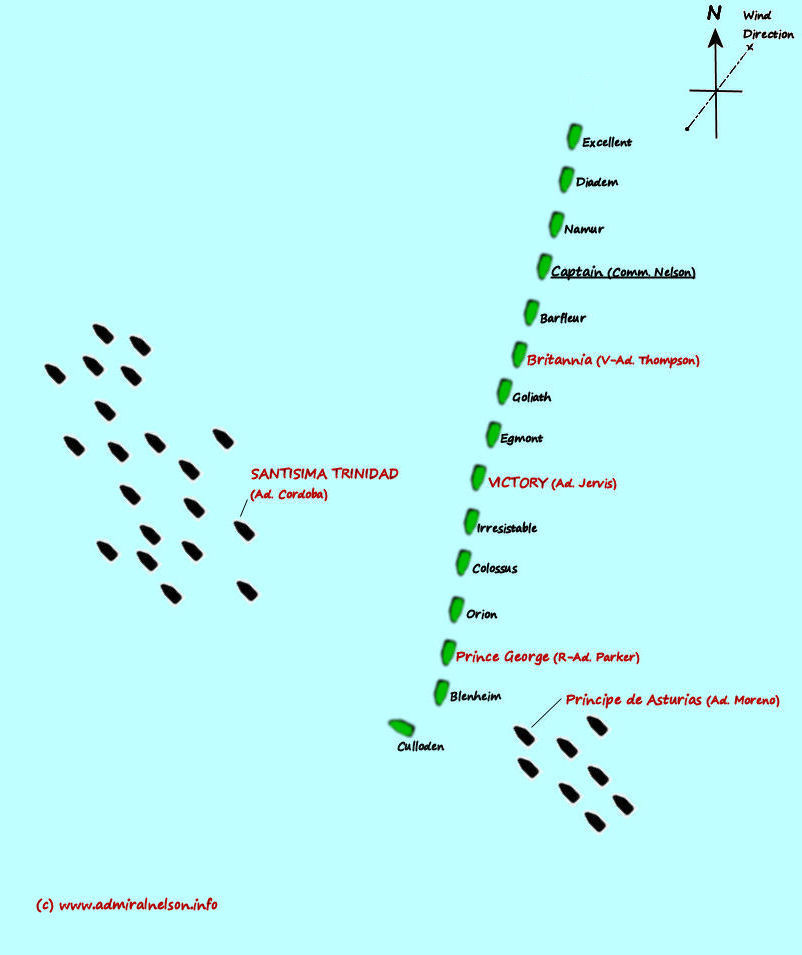
The British captains complied with his instructions cleanly, efficiently, and quickly, so quickly in fact that they bore down on the Spanish with a speed that took them by surprise. Captain Cuthbert Collingwood later described the approach as like swooping down on their opponents 'like a hawk to his prey'.
Nelson, in the Captain, moved behind Vice-Admiral William Waldegrave's ship, the Barfleur, in the rear division. Captain Decres of the Barfleur hailed him to say 'he was desired by the vice-admiral to express his pleasure at being supported by Sir Horatio Nelson'.
The hero of the approach was Captain Thomas Troubridge in the Culloden. He was at the lead of the British line, and raced to cut through the Spanish line before Moreno's division could catch up with the rest of them. As the gap began to close, it looked as if the Culloden might collide with Moreno's ship Principe de Asturias. But when the First Lieutenant told Troubridge this, he simply replied "Can't help it Griffiths, let the weakest fend off!". This was exactly the attitude which Jervis had worked to infuse into his captains, and most admired. As it turned out, the Principe de Asturias was the weakest - two broadsides from the Culloden saw her off and forced her to turn away.
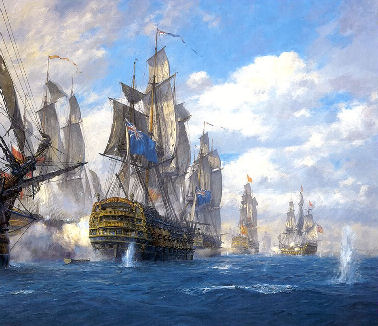
Admiral Moreno's Determined Counter-Attack
Now the division of the Spanish fleet was complete. As ship after ship passed through the gap, firing on Moreno's division, it became impossible for him to get past them.
Half an hour after his last signal, Jervis ordered the fleet to 'tack in succession'. This meant that they would all turn at the same point, following the leading ship and keeping the line intact.
Troubridge had been prepared for this order, and as soon as he saw the signal immediately turned the Culloden, heading towards the main body of the Spanish. But this manoeuvre was not without its difficulties. During the turn, the ships would leave their sterns vulnerable to enemy broadsides, and Moreno recognised this. If he could identify the turning point and position his ships there, he could cause significant damage.
The second British ship, the Blenheim, successfully followed the Culloden's turn. The third ship, the Prince George, flagship of Rear-Admiral Parker who led the van division, also made the turn, but by this time the Principe de Asturias was coming to attack with four other ships. The Orion then made the turn but the Colossus behind her was not so lucky. She came under fire from Moreno's ships and some of her sails were destroyed, so she went out of control. Moreno did not waste time in ordering his crew to prepare to board the Colossus but, as the British ship dropped out of the line, Captain Saumarez slowed the Orion so was able to cover her, and shot at the Principe de Asturias. The Colossus continued to drift northwards, and the next ship in the British line, the Irresistible, was able to get alongside the Spanish ship and fire at her. Under such heavy fire, there was no way the Spanish could even attempt to board the stricken Colossus.
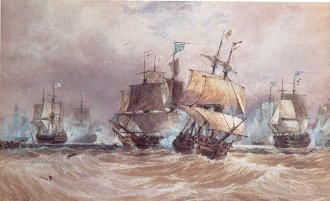
As the Irresistible completed her turn, it was Jervis' flagship, the Victory, that next came under fire from Moreno's undeterred attacks. But when the Victory came to a stop, the Principe de Asturias was forced to turn suddenly, putting her in the perfect position to receive massive broadsides from the British admiral's flagship.
Still, Moreno doggedly continued his attacks. The Egmont, coming up behind the Victory, was fired upon by two of the ships in his division. The Goliath came next and exchanged fire with the Principe de Asturias and Conde de Regla. She managed to complete her turn, but the determined Spanish attack had left her rigging badly damaged.
An hour after the British had cut the line, Moreno finally gave up, and decided to attempt to go around the front of the British line and join up with Córdova's division that way. His repeated and determined attacks, coming under fire from several British ships, earned Nelson's praise, who later said that he "did everything which a good officer could do to attempt to cut through the British line".
Moreno may not have succeeded in penetrating the British line, but his defeat of the Colossus, and forcing the Victory to stop and fend him off, meant that Troubridge's Culloden was pulling ahead of the rest of the British line and was about to reach the Spanish fleet with little support and completely exposed to heavy Spanish fire.
As Jervis went up onto the Victory's poop deck, the better to view and assess the situation, a seaman standing near him had his head blown off by a Spanish shot, covering him in brains and blood. The Victory's captain, George Grey, initially thought that the blood was Jervis' own and rushed up to check he was ok. Unfazed by the incident, Jervis continued his deliberations, but did ask for an orange so he could rinse his mouth.
If the Culloden continued on her current course, she'd put herself in grave danger. So the obvious option seemed to be to signal for her to withdraw and wait for the rest of the British. But this could give Córdova chance to escape, so instead Jervis altered his strategy. He signalled to the Britannia, the flagship of Vice-Admiral Thompson leading the rear division, for 'the leading ship to tack and others in succession'. This manoeuvre would effectively split the fleet into two lines, enabling the rear division to reach the Spanish and attack earlier than if they'd continued to the original turning point. He followed this up with a signal to every ship to 'take up suitable stations for mutual support and engage the enemy as arriving up in succession'.
But Thompson in the Britannia did not follow the order, and did not turn.
Copyright Vicki Singleton 2013.